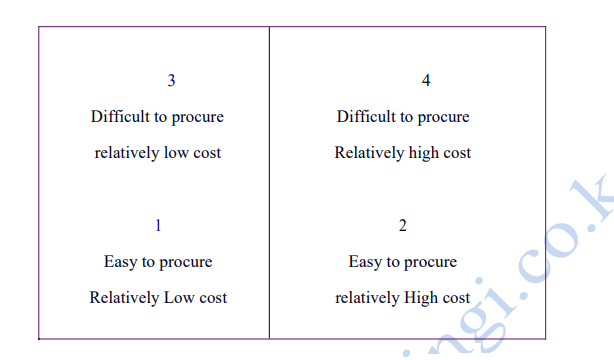Profiling will involve analyzing all your procurement packages and putting them into four groups taking into consideration the value of the procurement packages and the degree of difficulty in procuring the packages as shown in (a) above:
Procurement Profile details

1. Items in the first category (1) are relatively low cost as individual items. However collectively they may amount to a lot of money. The items are also easy to procure. The procurement of these items will in most cases be done by the procurement unit and contracts
awarded by the procurement committee however some of the contracts shall be awarded by the tender committee. The suitable method of procurement will be: –
- Request for quotations
- Low value procurement method
- Open tender where the items are put together and term contracts awarded.
2. Items in the second category (2) will be relatively high in expenditure as individual items. Collectively they shall also relatively high in expenditure. Most equipment bought will fall in this category. The items are however easy to procure and they will in most cases be readily available in the market. The most suitable method of procurement for these items shall be:
- Open tender
- Restricted tender
- Request for proposals (RFP)
3. Items in the third category (3) will be relatively low in expenditure but relatively difficult to procure. The best example of this category are spare parts for equipment an laboratory items which will need to be imported. Some medical items like drugs may also fall in this category. The procurement of these items will require cooperation of the procurements unit and the user department all the way through. The suitable methods of procurement for these items will be: –
- Open tender
- Restricted tender
- Direct procurement
- Request for quotations
4. Items in t he fourth category will in most cases be of relatively very high expenditure. They will also be difficult to procure and in some cases complex and very high cost. Almost all constructions and capital projects will fall in this category. The procurement of these items will require the attention of the procurement unit, user department, tender evaluation committee, Accounting Officer and top management.
The suitable method of procurement for these items will be: –
Pre-qualification tender
BENEFITS OR ROLE PLANNING IN PROCUREMENT CYCLE
1. Helps decide what to buy when and from what source.
2. Planning allows planners to determine if expectations are realistic particularly the expectations of the requesting entities.
3. Creates an opportunity for all the stakeholders involved in the process to meet in order to discuss particular procurement requirements i.e. the requesting entity, end users procurement department ,vendors, technical experts etc.
4. Planners can estimate the time required to complete the procurement process and award contract for each requirement.
5. Planners can access feasibility of combining or dividing procurement requirements into different contract packages.
6. Permits the creation of procurement strategy for procuring each requirement that will be included in the procurement plan.
7. Need for technical expertise to develop technical specifications or scope of work for certain requirements can be accessed. Procurement plan is the product of the procurement process.
